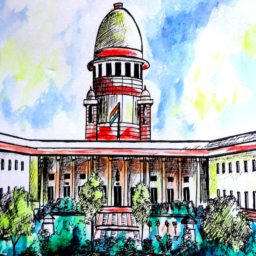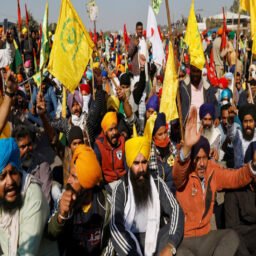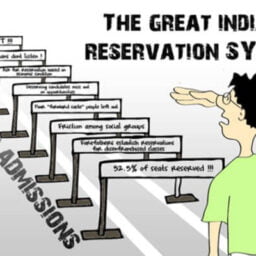INTRODUCTION
The Indian Constitution gives out detailed rules for achieving gender equality in the country. If women are left aside, a country’s journey to development can never be successful. No other branch of government could help make this de jure equality a de facto reality. At this point, it is critical to provide light on the practical judicial stance to women. This article discusses a few judgments that show the Indian judiciary’s commitment to the successful implementation of female rights. The Constitution guarantees women’s equality, guarantees equality before the law, and forbids discrimination based on religion, race, caste, sex, or place of birth. Nevertheless, it also permits for ‘personal’ laws, leading in a dual system which permits for gender discrimination. But from the recent Judgements from the apex courts, it is clear that modern Judiciary is committed and striving hard to acknowledge Gender equality and for women rights.
Vishaka and ors v. State of Rajasthan[1]
Bhanwari Devi tried to stop the marriage of an infant as part of her duty and to combat the masculine ego prominent in rural Rajasthan. She, on the other hand, flopped, and the marriage was a success. Five men gang-raped her in retaliation for her boldness in speaking out against them and the institution of child marriage. By failing to aid her correctly, police and physicians subjected her to inhumane torture. Despite her helplessness, she remained motivated and hopeful. An organisation called ‘Vishaka’ filed a writ petition. The PIL requested rules for preventing sexual harassment in the workplace. Sexual harassment was found to be a blatant violation of Articles 14, 19, & 21 of the Constitution, according to a broader interpretation of the Constitution. The Supreme Court published the Vishaka guidelines, which described sexual harassment as well as placed the responsibility for providing a safe working place for women.
These orders were now obligatory on all of India as law and courts had to obligatorily execute them. These guidelines were later transformed into The Sexual Harassment of Women at Workplace (Prevention, Prohibition, and Redressal) Act, 2013[2], which is the most amazing piece of legislation that acts as a great savior for women workers. This case is a shining instance of judicial activism, since the court took reasonable action to ensure a healthy working environment.
Shayaro Bano v. Union of India[3]
The Supreme Court issued a major ruling on the constitutional legitimacy of “Talaq-e-Biddat,” also known as “Triple Talaq,” that is one of three male-initiated divorces in the Muslim society, the other two were “Talaq ahasan” & “Talaq hasan.” As the term implies, a Muslim man can instantaneously divorce his wife by saying the word “talaq” in one seating, without the need for state participation. The channels of communication could be written, verbal, or even technological in this case, increasing a woman’s susceptibility in an arbitrary as well as unilateral divorce.
This contentious custom, which intersects gender identity as well as community, has left Muslim women vulnerable to mistreatment and in a tragic state, especially given the social economic facet, where the majority of women are financially reliant on their husbands, as well as the additional fear of this arbitrary divorce leaves many instances of marital harassment unaddressed. This practice was demeaning to women’s integrity and equality, as it breached our Constitution’s Articles 14, 12, 21, and 25. It is hoped that this decision will be considered in the light of day, and that it will assist Muslim women in living a better and more secure life as guaranteed by the law of the land.[4]
Indian Young Lawyer’s association v. State of Kerala[5]
The age-old prohibition on females between the ages of 10 and 50 entering the Sabrimala shrine, where Lord Ayyappa is worshipped, was removed by a Constitutional bench of the Supreme Court, led by CJI Dipak Misra. Protests erupted in Kerala as the long-awaited decision was handed down. As the honorable justices pointed out, devotion and faith should not be exposed to gender discrimination. In today’s world, stereotyping menstruation women would allow religious patriarchy to thrive. The ban on entry infringed on a woman’s right to worship, as guaranteed by Articles 14 and 25 of the Constitution. This verdict made a great contribution to gender justice and equality. Religious freedoms are vital to the operation of democracy in a nation like India. Constitutional ideals as well as reality, as we all know, are as far apart as possible for society’s seamless & decent operating. The Supreme Court attempted to fill the gap among constitutional ideologies as well as sociocultural context in the case of “Indian Young Lawyers Association v. State of Kerala & ors.”
Mary Roy v. State of Kerala[6]
Patriarchal customs barred women from the Syrian Christian minority in Kerala from acquiring property. Mary Roy, a woman’s rights activist & educator, protested the decision. She initiated a lawsuit against her elder brother when her father died and she was refused an equal portion of the family’s wealth. The Kerala High Court overturned the lower court’s decision, notwithstanding the fact that the plea had been dismissed by the lower court. The Supreme Court issued a significant decision in 1986, allowing Syrian Christian women to claim an equal part of their father’s property. The court ruled that no personal law could be prioritised or held above the Indian Constitution, and that any conduct in a field that refutes the relevance and value of the constitution’s provisions will be declared illegal and inapplicable. This decision is a watershed moment in Indian history since it empowers women to speak out and defend their rights. The patriarchal culture became defensive and uneasy as a result of this decision.
This was a watershed moment in history, challenging patriarchal and traditional society at every turn and forcing people to reassess their attitudes about women. This decision also encouraged women to speak up and fight for their rights when faced with injustice. This ruling also overturned antiquated rules that discriminated against women based on their gender and returned equal rights for both men and women.[7]
State of Tamil Nadu v. Suhas Katti[8]
The first conviction under the Information Technology Act of 2000 resulted from this case. When the complainant declined to marry the accused, Suhas Katti, she was tormented. In a Yahoo message group, he started sending her slanderous and vulgar comments. To make matters worse, she started receiving phone calls from anonymous persons offering her sex work. The victim lodged a complaint in February 2004, and the accused was found guilty seven months later. This judgement serves as a weapon for women to protect their dignity in an age of ruthless trolls & other kinds of internet harassment. This case is the first in the history of the Indian judicial system to punish someone for sending vulgar texts to a woman, causing her reputation as well as character to be harmed, as well as outraging her modesty.
CONCLUSION
Because of its strong customs and various cultures, attaining complete gender justice in India is challenging. The dismal situation of women in our country can be attributed to poor law enforcement, underground sexism, absence of financial dependency, and awareness among women. Several non-governmental organisations, human rights defenders, the United Nations, and other government institutions have spoken out against gender discrimination. Simply put, every welfare state must ensure that all genders are treated equally. The Younger generations should be teached regarding respecting women and girl’s dignity and honor. In this mission, Parents play a crucial role, they should teach their child to behave with women and girls in a dignified manner and should inculcate them some ethics right from their childhood.
Author(s) Name: T. Sree Sai Kundhan (Damodaram Sanjivayya National Law University, Vishakapatnam)
References:
[1]Vishaka and ors v State of Rajasthan [1997] AIR 3011 (SC)
[2] The Sexual Harassment of Women at Workplace (Prevention, Prohibition, and Redressal) Act, 2013
[3] Shayaro Bano v Union of India [2017] SCC 963 (SC)
[4] ‘Triple Talaq: Shayaro Bano vs Union of India’ (Supreme court observer, 22 Aug 2017) <https://www.scobserver.in/court-case/triple-talaq-case> accessed on 11 Sep 2021
[5] Indian Young Lawyer’s association v State of Kerala [2018] SCC 1690 (SC)
[6] Mary Roy v State of Kerala [1986] AIR 1011 (SC)
[7] Asmitha Shay, ‘Mrs. Mary Roy vs. State of Kerala’ (Lawtimes Journal) <https://lawtimesjournal.in/mrs-mary-roy-vs-state-of-kerala/> accessed on 12 Sep 2021
[8] State of T.N v Suhas Katti [2004] C No. 4680













